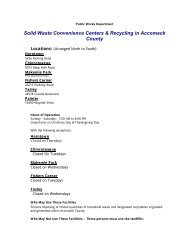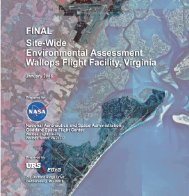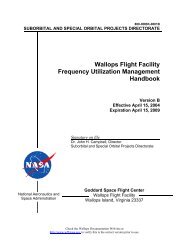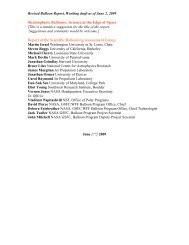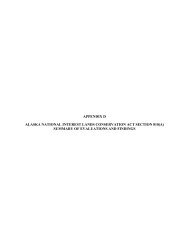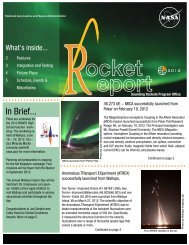Alternative Energy Draft EA - NASA Visitor Center at Wallops Flight ...
Alternative Energy Draft EA - NASA Visitor Center at Wallops Flight ...
Alternative Energy Draft EA - NASA Visitor Center at Wallops Flight ...
Create successful ePaper yourself
Turn your PDF publications into a flip-book with our unique Google optimized e-Paper software.
Environmental Consequences<br />
is the approved harvest of large numbers of w<strong>at</strong>erfowl each year. The Commonwealth of<br />
Virginia allows harvest of w<strong>at</strong>erfowl in numbers th<strong>at</strong> would not be m<strong>at</strong>ched by the f<strong>at</strong>ality from<br />
the proposed wind turbines <strong>at</strong> WFF. According to the USFWS (Richkus et al., 2008), Virginia<br />
harvested more than 131,000 ducks in 2006 and 2007, a small proportion (approxim<strong>at</strong>ely 8<br />
percent) of the total number of ducks harvested along the Atlantic Flyway in those same years.<br />
The USFWS also allows for localized management of Double-crested Cormorant, one of the<br />
identified carcasses <strong>at</strong> WFF, because it can be a nuisance species in certain areas. These<br />
examples demonstr<strong>at</strong>e th<strong>at</strong> there are gre<strong>at</strong>er thre<strong>at</strong>s to avifauna <strong>at</strong> the individual and popul<strong>at</strong>ion<br />
level than the two proposed wind turbines <strong>at</strong> WFF.<br />
A post-construction monitoring study has been proposed (<strong>NASA</strong>, 2009d) as a means of ground<br />
truthing the wind turbine’s risk profile and to provide d<strong>at</strong>a for comparison of actual avian and b<strong>at</strong><br />
mortality <strong>at</strong> the wind turbines with mortality estim<strong>at</strong>ed for the existing tower structures. The<br />
need for BMPs would be determined once the post-construction study is implemented. If it is<br />
determined th<strong>at</strong> there is a need to mitig<strong>at</strong>e for any potential impacts on avifauna <strong>at</strong> the proposed<br />
WFF wind turbines, potential avoidance and/or minimiz<strong>at</strong>ion BMPs could be implemented to<br />
reduce the potential long-term (direct and indirect) impacts. Since research is on-going regarding<br />
wind energy projects and how to avoid and minimize potential impacts, many BMPs have yet to<br />
be developed and/or proven. Details of the mitig<strong>at</strong>ion measures and proposed post-construction<br />
study can be found in Chapter 5 of this <strong>EA</strong>.<br />
Residential-Scale (2.4 kW) Wind Turbines<br />
A qualit<strong>at</strong>ive evalu<strong>at</strong>ion of the potential for risk to birds from residential-scale turbines is<br />
provided in the absence of site-specific inform<strong>at</strong>ion. The general assumption is th<strong>at</strong> small,<br />
residential-scale wind projects have minimal impacts on birds and less impact than the larger<br />
utility-scale turbines. For example, the American Wind <strong>Energy</strong> Associ<strong>at</strong>ion (AW<strong>EA</strong>) says th<strong>at</strong><br />
“anecdotal evidence indic<strong>at</strong>es th<strong>at</strong> birds occasionally collide with small wind turbines as they do<br />
with any other type of structure. However, such events are rare and very unlikely to have any<br />
impact on bird popul<strong>at</strong>ions. Large, utility-scale wind turbines account for less than 0.003% of all<br />
human-caused bird de<strong>at</strong>hs, and small wind turbines have even less of an impact.”<br />
Further, Southwest Windpower, Inc., the manufacturer of 2.4 kW turbines, st<strong>at</strong>es in their<br />
Residential Wind and Birds fact sheet th<strong>at</strong> “although no formal studies have been conducted with<br />
residential wind gener<strong>at</strong>ors like those produced by Southwest Windpower, Inc., bird strikes are<br />
even rarer. This is due in part to their shorter towers [9-30 meters (30-110 feet)], and rel<strong>at</strong>ively<br />
small blades [1-3 meters (3-12 feet)] in diameter. Also, residential wind gener<strong>at</strong>ors are typically<br />
installed over a more dispersed area, further reducing the chance of bird collision.” Neither<br />
AW<strong>EA</strong> nor Southwest Windpower, Inc. track avian mortality <strong>at</strong> residential-scale windfarms and,<br />
therefore, project-specific inform<strong>at</strong>ion was sought during a liter<strong>at</strong>ure review.<br />
A review of relevant liter<strong>at</strong>ure and discussions with industry experts were conducted to<br />
determine if there were post-construction monitoring results for projects similar to WFF th<strong>at</strong><br />
would be instructive in assessing the potential for avian risk from the 2.4 kW turbines. Postconstruction<br />
monitoring to assess avian mortality r<strong>at</strong>es generally has been conducted <strong>at</strong> the larger<br />
utility-scale projects and not on the smaller turbines projects like the 2.4 kW turbines proposed <strong>at</strong><br />
WFF. In a review of avian mortality d<strong>at</strong>a for 33 wind turbine sites in the United St<strong>at</strong>es and<br />
Canada, Barclay, et al. (2007) determined th<strong>at</strong> th<strong>at</strong> the height of turbines had no effect on bird<br />
mortality r<strong>at</strong>e (corrected mortality r<strong>at</strong>es ranged between zero and nine per turbine per year). With<br />
115




